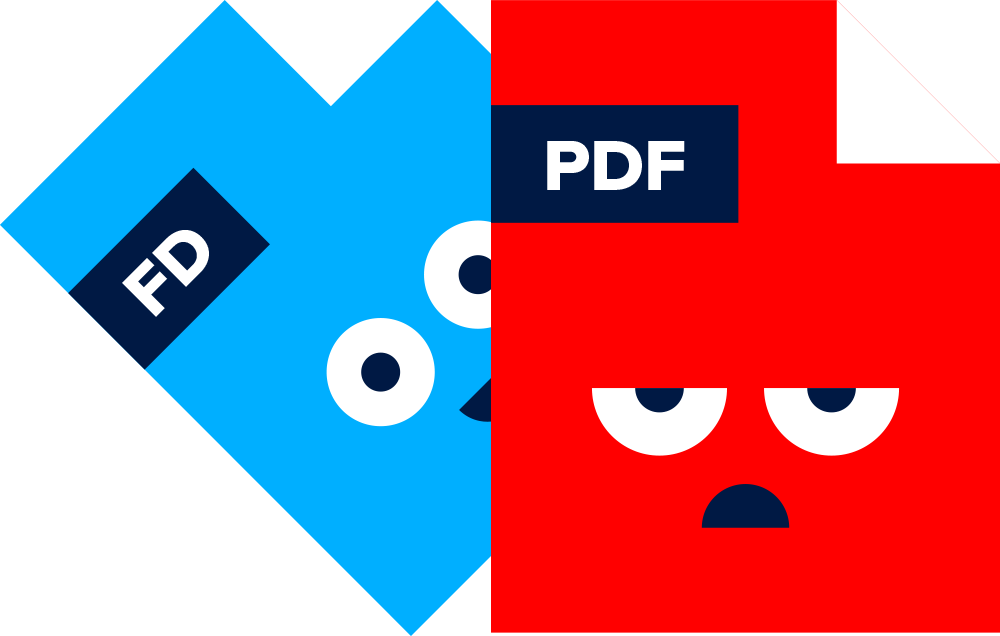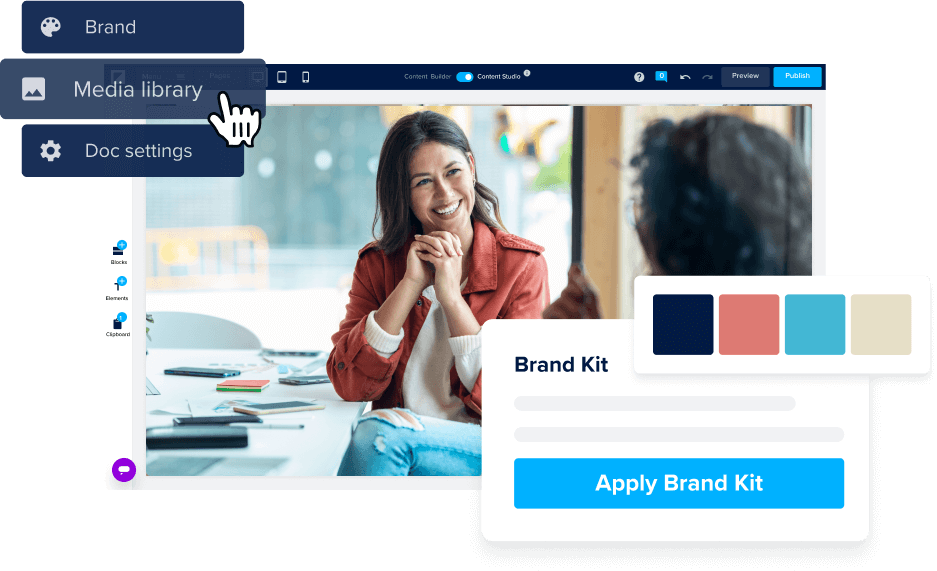Inbound B2B marketing is all about establishing credibility and building trust. When done well, it enables marketers to create strong, lasting relationships with people that have already shown an interest in their products or services.
Using B2B inbound marketing tactics is also a highly cost-effective and measurable way of increasing brand awareness and generating leads and sales.
But creating and delivering an effective B2B inbound marketing strategy takes time, so marketers need to be sure their activities will yield ROI, improve brand visibility, and drive conversions.
This article will talk you through everything you need to know about boosting your B2B inbound marketing tactics, from deciding which activities are right for your company to top tips for nurturing leads throughout the buyer journey.
Create your buyer personas
Buyer personas are semi-fictionalized descriptions of your ideal customer. They help brands focus on the characteristics, challenges, goals, and aspirations of the people they want to attract. You will need to create a buyer persona for every market you are targeting and review them regularly to make sure they reflect your customers’ changing needs and profiles.
For top tips on getting it right the first time, check out our guide to using personas for content marketing.
Decide which B2B inbound marketing activities are right for your business.
Brands don’t need to be everything to everyone. You simply need to be where your customers are, right when they need you. Deciding on the best marketing activities to reach your customers is key to your success. A good place to start is by answering these questions:
- Who are your target buyer personas?
- What do they need from you, and why?
- What social media platforms do they prefer and why?
- Where do they get their news, and who are the thought leaders or influencers they trust?
- What are your inbound marketing goals and objectives? E.g., increase social media engagement, drive high-quality traffic to the website, boost brand awareness, and promote trust.
- How will you set and track KPIs and goals?
- What available resources do you have (talent, tools, etc.), and what gaps need to be filled?
When planning your activities, it’s important to keep in mind that targeting a B2B audience requires a different approach to B2C.
B2B customers want to be educated using highly detailed and precise content for inbound marketing, whereas B2C customers will respond to entertaining and emotional content when making a purchase.
Discover: B2B Lead Generation Strategies You Should Be Using in 2023.
Choose the right B2B inbound marketing channels
A scattergun approach rarely works when choosing the right B2B inbound marketing channels. As mentioned above, you need to be where your customers are, at the stage in the buyer journey when they need you the most.
Here are some of the best B2B inbound marketing channels to choose from and why they work.
- Company website
Your website is the heart of your marketing strategy, bringing all your inbound activities together under one (searchable) roof. Your website is often the first interaction customers have with your business, so the buyer journey must be optimized, the content fresh and compelling, and the design slick and professional.
Helpful hint: By regularly monitoring your website analytics, you can identify any issues with user experience, improve visitor journey, identify content gaps, detect technical issues, and much more. Find out how to use and understand Google Analytics in 2021 and beyond.
- Search Engine Optimization (SEO)
SEO provides two great benefits to B2B marketers. Firstly, by adding popular keywords and search terms strategically into your website content and title tags, you can make it more visible to potential customers and drive high-quality traffic to your website.
Secondly, you can implement effective backlinks outsourcing strategies from trusted and authoritative websites to raise the profile of your valuable homegrown content. Both B2B inbound marketing tactics indicate to search engines that your content is useful and trusted and should mean you get found by the right people.
- Content marketing
Content marketing continues to be central to a successful B2B inbound marketing strategy. By producing useful, relevant, timely content, you’ll help people understand your brand and products, address sales barriers, answer questions, and offer your opinion on industry trends, thereby demonstrating that all-important thought leadership.
From blogs that offer broader market insights to case studies telling the story of your product’s benefits, content marketing should be a key focus of your inbound market activities.
- Email marketing
Email marketing is a valuable tool in your inbound B2B marketing arsenal. This channel enables marketers to offer leads useful content to help them achieve specific goals, solve problems, and encourage them to progress through the sales funnel. Furthermore, your email marketing analytics highlight which content is getting the most engagement which helps inform your wider content marketing strategy.
- Social media
Social media is a great channel for amplifying your content, forming partnerships, and connecting with your audience. It’s also a great way to humanize your brand. Busy marketers often struggle to manage multiple accounts, so do your research and focus on the ones that your customers and leads prefer.
Helpful hint: For digital business content that you plan to use for your prospects and customers — like magazines, proposals, white papers, ABM assets, etc. — it's high time to switch to a more powerful format that takes modern requirements like measurability and responsiveness into consideration.
Check out our article on why the world must move past PDFs and how you can start to create interactive content.
Create a content marketing funnel
Delivering valuable, relevant content to customers that aren’t yet ready to buy is one of the most effective ways to build trust and demonstrate the value of your brand and products. To do this successfully, you need to understand the buyer’s journey and how to reach them. That’s where a content marketing funnel comes in. The funnel can be divided into the following three stages, making it easier to decide which content fits the different steps in the journey to map your content and deliver it at exactly the right time.
Top of the Funnel (TOFU - Awareness stage)
Middle of the Funnel (MOFU) - Consideration/evaluation stage
Bottom of the Funnel (BOFU) - Purchase/conversion stage
Content formats for Building Awareness (TOFU) -- This is your chance to attract leads to your website or social media by answering questions or offering solutions. Blogs, videos, white papers, e-books, and free tools or templates are great ways of doing this.
Content formats for consideration/evaluation -- Seize the opportunity to convince your leads that you’re the right solution for them with educational resources, email campaigns, and webinars.
Content formats for purchase/conversion -- Get those leads over the line with comparison studies, case studies, testimonials, video demos, and calculators.
Want to find out more? Take a look at our guide on how to map your content to the buyer journey.
Harness the power of interactive content
Automating elements of your inbound marketing processes means more time to write that amazing content that will boost SEO and drive sales and conversions. B2B marketers are increasingly using interactive content to attract and engage new customers, particularly since it is now possible to create media-rich content without specific technical skills. Sounds good? Take a look at what’s on offer from Foleon on creating interactive content that's 100% on brand.
Make the most of your testimonials and customer reviews
Trust indicators such as testimonials and customer reviews are marketing gold dust. Many B2B marketers struggle to get reviews from their customers, but it is worth taking the time to gather testimonials. They’re a great way of demonstrating high levels of customer satisfaction, driving new customer acquisition, and building stronger connections with your current customers.
Here are some tips for making the most of your testimonials.
- Think about the platforms you will use your testimonials on before you ask for them, and choose a format and interview process accordingly. For example, suppose the customer has an interesting or detailed story. In that case, you could craft it into a case study, highlighting snippets that could be used for quotes on marketing collateral or the company website. If the customer is willing, you could request a video interview, a format that often proves more engaging and encourages engagement on social media.
- Always try to include the reviewer’s full name, job title, and the company they work for. This demonstrates credibility, promotes trust, and helps readers imagine themselves in the satisfied customer’s shoes. You could also include their company logo and a photo of the customer, if appropriate.
- When publishing the reviews, categorize them by the product the customer purchased/uses, the sector they work in, the size of their business, or the problem your products or services solves. You’ll increase impact and streamline the buyer journey by directing your leads to the right testimonials straight away.
- Keep your content up to date. Five-year-old testimonials will lack relevance and could even seem untrustworthy.
Put your plan into motion
With a million day-to-day tasks already on the to-do list, it can feel like a lot to take on. But, when done well, a well-researched and well-thought-through inbound marketing plan can deliver amazing results for B2B brands.
When you have put your plans in motion, don’t forget to regularly check in with your analytics to make sure you are on the right track. Just half an hour a day checking your engagement metrics now and then can help identify easy fixes to increase your engagement, streamline the customer journey, and optimize your content marketing strategy.
B2B inbound marketing delivers qualified leads and measurable ROI. So, if you want to attract new customers and drive these valuable prospects through your sales funnel, allocating time and resources for your B2B inbound marketing strategy is a sound investment.





.png)